Motion Sensor Light Switches such as the unit pictured below are relatively new products which will only turn lights on in a room when it is occupied. By automatically turning off the lights when no-one is in the room and when the room is bright enough without the lights needing to be on, the manufacturers claim that an average of 128 hours per year of unnecessary lighting will be avoided, reducing electricity consumption for the lighting by 10%.
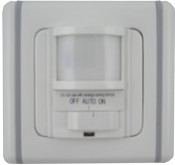
Exactly how much energy is actually saved by this type of light switch depends on the room in which it is fitted and the current behaviour of its inhabitants (i.e. do people often leave lights on when they leave a room). In frequently used rooms such as kitchens the benefits are small since lights left on unnecessarily are soon noticed and turned off. Where these switches come into their own is in store rooms, utility rooms, attics, garages, out-buildings, and other areas which may not see a person for days or weeks on end. They are also useful for commercial properties, public buildings, and workplaces where the people using the lights are not the people paying the electricity bills!
Motion sensor light switches are sold as a complete easy to install units which can be quickly fitted as a direct replacement for a standard (non-dimmer, single way) switch. The cheap and cheerful (£10) version pictured earlier has a manual switch so that lights can be switched ON or OFF, or to select AUTO mode. When in AUTO mode, the fitted PIR sensor (which covers 110 degrees with a range of 5 metres) detects if someone is in the room. A second adjustable light sensor ensures that the lights are only turned on when it is dark (see image below).
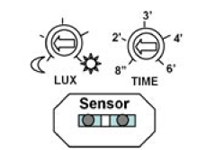
A delay time setting (8 secs to 6 mins) is provided so that you can set how often you want the motion detector to check the room for inhabitants. The longer this time is set, the longer the lights will remain on after you leave the room. The shorter the time, the more likely it is that the lights will turn off while you are still in the room – potentially a problem if you are sitting in an armchair not moving or walking backwards and forwards directly towards the motion sensor – another reason why these devices are not ideally suited for use in living areas.
Timeguard ZV810 Motion Sensing Light Switch
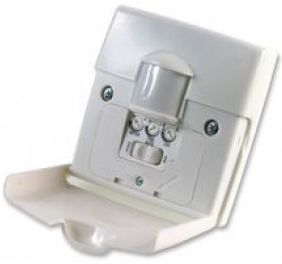
The light switch pictured above is the Timeguard ZV810), which offers more advanced features, and is available for around £30. It offers a light on time adjustable from 6 secs to 12 mins, a wide 180 degree detection angle, and can switch up to 500 Watts of incandescent light bulbs or 150W of low voltage spotlights.
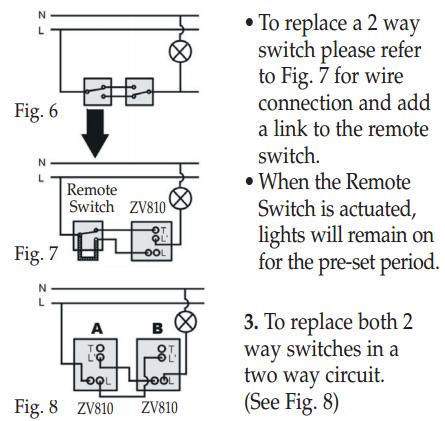
Above are wiring diagrams to show how these motion sensing light switches can be used with two-way switching applications – for example where there is a light switch at the top and bottom of a flight of stairs, or at either end of a long corridor. This comes from the ZV810 fitting and usage instructions(PDF) which can be downloaed here.
Buy a Motion Sensor Light Switch
A wide range of PIR Light Switches of differing qualities and offering different features are all available here with prices starting from under £10. Alternatively click here to purchase the ZV810 Motion Sensor Light Switch which comes with a manufacturer’s three year guarantee.
Reviews of Motion Sensor Light Switches
Since domestic motion sensor light switches are still quite new products it is well worth reading about the experiences (often disappointing) of those who have fitted them in their homes.
Installation of these switches can sometimes prove difficult as many require a deep box in the wall – problematic if the switch to be replaced was installed in a shallow box. Also many switches do not work properly or at all with LED lighting or energy saving light bulbs (CFL) – just incandescent, halogen, and fluorescent tubes. Therefore it is essential that you read the specifications of any switch carefully before making a purchase.
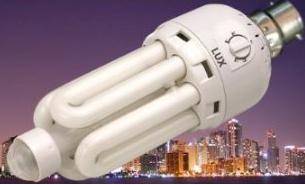
An alternative to motion sensing light switches is motion sensing light fittings. These fit between the bulb and the existing light fitting, or come as an integrated bulb and motion sensor unit (as pictured above) designed to fit directly into the existing bayonet or screw light fitting. Such devices are ideally suited for those in rental accommodation who are not permitted to change switchgear in their home.
The Economics of Motion Sensor Light Switches
One last thing to consider is the economic benefit (or otherwise) of a motion sensing light switch. The Timeguard ZV810 will control up to 150W of low voltage spotlights, costs £30, and should save on average 128 hours of unnecessary lighting usage per year. The cost of a unit (1kWh) of electricity in the UK is now (June 2013) around £0.15. Ignoring the fact that the light switch itself uses power constantly – just a few Watts, but it certainly adds up over a year – 128 hours of 150 Watts is 19.2 kWh of electricity saved, or £2.88 per year at today’s prices.
Therefore the payback period for such a switch is 10 years for the average user. If you used this switch to control just a single 60W incandescent bulb – in a pantry for example – it would take closer to 30 years to pay for itself, although it would surely fail long before then.
What the above shows is that these motion sensor light switches offer benefits for very particularly scenarios only, mostly commercial, but certainly not for your living room at home!